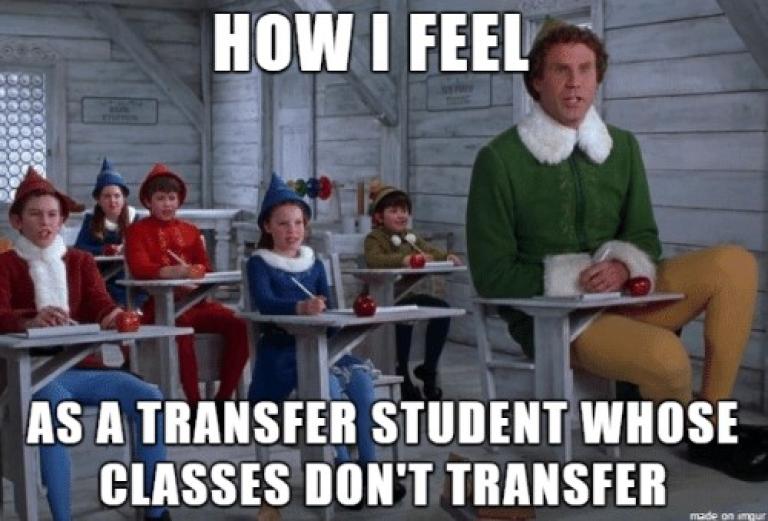Common Concerns
Most students and families approach the transfer process with at least some anxiety. When transfer was not part of the student’s original plan, it’s even more stressful. The application process will be much like it was for the first school, but students should think more carefully about their long-term goals and make sure that as many of their credits as possible are considered for transfer to their new college.

What’s Different About the Transfer Application Process?
Transferring students have already gone through an application process, and they probably had the assistance of a high school counselor, their parents, and admissions counselors at each school they applied to. Transfer admission is similar but with a few extra requirements.
Students who transfer during or after their first year will likely be assessed according to their high school record, along with their transcript from the college they attended. If they haven’t done well academically at the college level, a competitive school is unlikely to accept them. It can be easiest to apply at a school that originally accepted them. They can submit a letter explaining why they are leaving their first school and why they believe this next school is a good fit.
They may need a letter of recommendation from someone at the college they’re leaving--a professor, counselor, or employer. If they have not been engaged at college, it might be difficult to identify someone who can provide that reference. Because the school will be considering the student’s college record so far, it’s certainly best to have good grades and evidence of academic dedication, school or community involvement, and work experience. Students considering transfer during the freshman year might be more successful by staying for an extra semester or two and focusing on establishing good credentials. It’s usually easiest to transfer following the sophomore year, or at least after completing the first full year.
With a major in mind, students can go online or contact the admissions office to find out what programs a school offers that will match the student’s goals. They should also ask for information on job placement after graduation--what jobs do students from that major actually get?
A campus visit can clarify whether the school is likely to be a good fit. Just like the original college choice, a tour of campus and a meeting with admissions staff helps in the decision process. Even if the student visited as an incoming freshman, they should return to view campus from the perspective of a transfer student. The factors that will impact their decision are likely to have changed over time.
What Kind of Support Is Available for Transfer Students?

Most schools have admissions advisers who specialize in helping transfer applicants. After students are enrolled, they may find an academic adviser with a particular interest in supporting transfer students. However, there is often an expectation that transfer students should be familiar enough with higher education to advocate for themselves and find their own way. It is important that students seek out help when they need it and persist in getting answers to their questions.
As a new transfer student, fitting in socially will make a difference in their enjoyment and success in college. Most transfer students worry that they will have trouble finding friends their age, believing that friendships formed during the freshman year will not offer room for them. They can find out how transfers are welcomed by asking if the school offers a transfer orientation program--for students and for family members. Are there student organizations specifically for transfer students to connect with other transfers? Does the school provide housing for transfer students?
Students should recognize that every semester or term offers a fresh start for all students. There are plenty of people who want to continue meeting new friends throughout their college years. The best advice for transfers is to introduce themselves to people sitting near them on the first day of class; join campus organizations based around the student’s major or favorite activities where they can meet like-minded friends; and be open to inviting classmates to form a study group or go out for coffee or lunch after class. Friendships develop over time, through shared experiences and common interests.
Will Credits Transfer?

A significant concern is whether credits already completed will count at the new school. Does transferring mean it will take longer to graduate? A study by the U.S. Government Accounting Office found that on average, students lost 43% of their credits when they transferred.
Students should work with both the school they are leaving and the one they’re transferring to in order to limit loss of credits. They will need to provide a transcript of their courses to the admissions office at the new school to assess and confirm transfer of credits. A number of schools have established partnership agreements, or articulation agreements, outlining how courses will transfer. A beginning point is to check with both schools on transfer policies. Students can talk to a counselor at their original school for information on which schools they most often transfer students to, and with admissions staff at the transfer school.
Additionally, students can visit the CollegeSource website, Transferology, to get an idea of how their credits are likely to transfer between schools.
Students who had Advanced Placement (AP) or International Baccalaureate (IB) credit when they began college should check with the new institution to determine if those credits will qualify.
What Is the Financial Impact?

Transferring can have a significant impact on the cost of college--sometimes reducing the cost, and sometimes raising it significantly. Parents and students may want to consider the cost difference together.
Grants and scholarships provided by the original school will probably not apply at a new institution. Scholarships from outside sources (job-related, corporate, association, or organization scholarships) may transfer, but students should confirm whether these will apply at the school they’re planning to attend. Some scholarships may require a payback if the student doesn’t fulfill the requirements that were stipulated upon in the award; this would include paying back scholarship funds if the student drops out without completing a semester or didn’t achieve a required grade point average. If a student leaves school mid-semester, there may be housing costs that apply for the rest of the term, and the student may owe tuition and fees for the full semester.
If the student is transferring to a different state, any state aid previously awarded is unlikely to be available. Students should ask an admissions counselor about the possibility of financial aid available to transfer students, including grants, scholarships, or work-study.
Federal aid is likely to continue, but students must request a review from the Free Application for Federal Student Aid (FAFSA). The amount of expected student and parent contributions will then be calculated by the new institution, and the student will receive an award letter from the new institution.